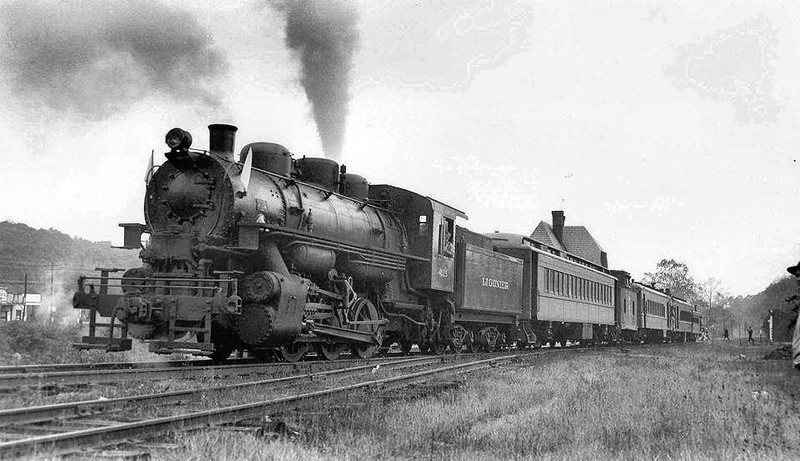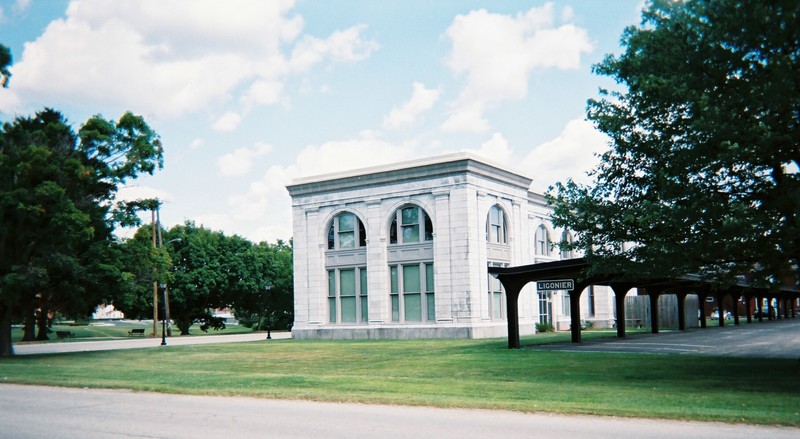Ligonier Valley Rail Road Museum
Introduction
Text-to-speech Audio
Images
The Ligonier Valley Rail Road Museum is located in the restored Darlington Station, built around 1900.

Train with the word "Ligonier" along the side riding the Ligonier Valley Rail Road.

1912 collision on the Ligonier Valley Rail Road, called "the worst ever known in the history of Westmoreland county railroading" by the Ligonier Echo.

"The Liggie's" former Ligonier depot and headquarters, now used as offices by the local school district.

Backstory and Context
Text-to-speech Audio
According to the Ligonier Valley Rail Road Association, the railroad was "short in length," but "long in construction." In 1853, the Pennsylvania General Assembly passed an act incorporating a railroad company between Latrobe and Ligonier. Originally called the Latrobe and Ligonier Rail Road Company, this line connected the newly formed town of Latrobe, which was laid out by an engineer for the Pennsylvania Railroad, and Ligonier, a settlement first established about a hundred years earlier during the French and Indian War.
Surveys for the new railroad were completed in 1853 and 1854, yet financial issues and delays from the state legislature made grading and construction a slow process. The railroad was renamed the Ligonier Valley Rail Road Company in May 1871, with additional surveys conducted - and additional delays. The incomplete railroad went up for sale and was purchased by Judge Thomas Mellon, founder of Mellon Bank in Pittsburgh, in August 1877.
Mellon saw the Ligonier Valley Rail Road as less of an financial investment and more of an opportunity to give business experience to his sons, Andrew Mellon (later president of Mellon Bank and U.S. Secretary of the Treasury) and Richard Mellon (also later president of Mellon Bank and founder of the Rolling Rock Club). Mellon opted to construct a narrow gauge (3 foot) line, which was completed and went into service on December 1, 1877.
The narrow gauge line made it impossible to directly interchange equipment with the Pennsylvania Railroad, which operated on standard gauge. The Ligonier Valley Rail Road was the first company to use a car transfer system invented by Robert H. Ramsey in 1878. Persisting complications and expenses led the company to convert the railroad to standard gauge (4 foot, 8.5 inches) in 1882.
Nicknamed "The Liggie," the mainline had passenger stations or shelters at Ligonier, Bells, Millbank, Idlewild, Darlington, Long Bridge, Kingston, Osborne, Oakville and Latrobe, with three to five weekday round trips between Latrobe and Ligonier. The Mellons established a park, Idlewild, in 1878 to attract passengers from Pittsburgh as well as local communities to the beautiful Ligonier Valley. The Ligonier Valley Rail Road also carried express and U.S. mail and hauled freight including mineral products, stone, coal, coke, and timber. The worst disaster on the Ligonier Valley Rail Road occurred July 5, 1912, when a passenger train carrying holiday travelers and freight train collided head-on along the Wilpen branch of the railroad. In total, 26 people died and 29 were injured, including many children.
Since the railroad relied heavily on industrial freight for income, the decline of local industry eventually led to the Ligonier Valley Rail Road's closure on August 31, 1952. The state condemned the section of line through the Loyalhanna Gorge to expand the Lincoln Highway, now the westbound lanes of Route 30 into Latrobe.
The nonprofit Ligonier Valley Rail Road Association (LVRRA) acquired the Darlington Station property in 2005. Major funding from the Richard King Mellon Foundation, Allegheny Foundation, and Kennywood Entertainment (parent company of Idlewild Park) helped the LVRRA restore the Darlington Station and transform the space into a museum. The Darlington Station, built around 1900, was both the workplace and residence of the agent operating the station, and included a ticket office, waiting room, and convenience store. After the Ligonier Valley Rail Road was closed, Idlewild Park took ownership of the property and used it as a quarters for park employees.
The Ligonier Valley Rail Road Museum opened on May 21, 2010 and offers exhibits, guided tours, programs, and research opportunities. The Museum also continues to collect objects and documents related to the Ligonier Valley Rail Road, its largest object being a restored 1905 Bobber Caboose that visitors can explore inside.
Sources
About the Ligonier Valley Rail Road Association, Ligonier Valley Rail Road Association. Accessed March 24th 2020. https://www.lvrra.org/about.php.
A Brief History of the Mainline of the Ligonier Valley Rail Road. Ligonier Valley Rail Road Association. Accessed March 24th 2020. https://www.lvrra.org/LVRRA_history.php
Ligonier Valley Rail Road 1912 Wreck. Ligonier Valley Rail Road Association. Accessed March 24th 2020. https://www.lvrra.org/1912_wreck.php
Idlewild Park and LVRRA Save Historic Landmark, Ligonier Valley Rail Road Association. Published October 11, 2006. Accessed March 24th 2020. https://www.lvrra.org/darlington_station.php.
1905 Bobber Caboose. Ligonier Valley Rail Road Association. Accessed March 24th 2020. https://www.lvrra.org/bobber_caboose.php
Ligonier Valley Rail Road Museum, Laurel Highlands Visitors Bureau. https://www.laurelhighlands.org/listing/ligonier-valley-rail-road-museum/311/
Ligonier Valley Rail Road Museum. https://www.lvrra.org/pix/lvrr-1-lg.jpg.
Ligonier Valley Rail Road Museum. https://www.lvrra.org/1912_wreck.php
By Canadian2006 - Own workby uploader, CC BY-SA 3.0, https://commons.wikimedia.org/w/index.php?curid=4722258
